Living the Peripheries: Key Findings
This blog, authored by Paula Meth and drawing on the writings of her collaborators and findings of the ESRC-funded project Living the Urban Periphery: Investment, Infrastructure and Economic Change in African City-Regions, presents some of the key findings of the recently completed comparative research in South Africa and Ethiopia. More information on the project is available here. All images featured in the blog are by Mark Lewis.
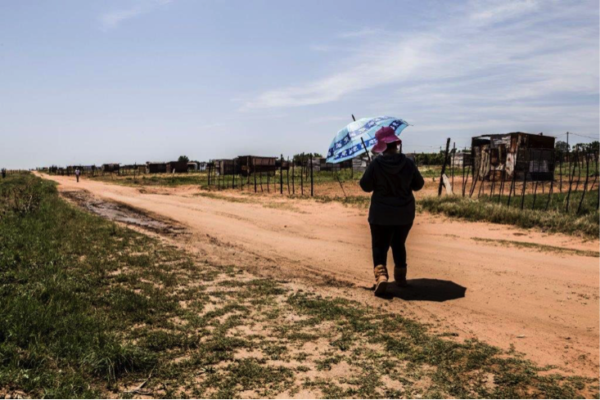
The overall aim of the ‘Living the Peripheries’ project (February 2016 to June 2019) was to understand the drivers behind urban change and how residents in the peripheries of three city-regions in Africa experience everyday life in relation to these changes. The project drew on a mixed methods approach focusing on seven multi-nodal cases across the city-regions of eThekwini and Gauteng in South Africa and Addis Ababa in Ethiopia. The team consisted of colleagues working in the UK, South Africa and Ethiopia.
A substantial amount of qualitative and quantitative data was generated. The project used a collaborative format (including multiple writing workshops) with researchers from partnering universities working together to analyse findings, and to conceptualise, generate and disseminate outputs. This blog identifies some of the key findings that have emerged from the project, recognising that in reality they are far more complex and context-specific. More nuanced accounts of findings will emerge in our journal publications and proposed edited book.
Recognising the diversity of the ‘urban periphery’
The first key finding is that experiences of living in the urban peripheries are relational and differentiated through intersections of gender, class, generational difference, disability, citizenship and those with/out access to private transport. As a result, we argue that there is no singular ‘urban periphery’, rather what we evidence is multiple peripheries and also the presence of peripheries within the periphery. Some spaces within these urban peripheries are far more marginalised than others, and there are clear pockets of privilege too. This in turn means that living in the peripheries is not a homogenous experience, and thus does not shape well-being in homogenous ways.
Related to this, our study shows that there are multiple logics underpinning why people live in the urban peripheries, which in turn shape their abilities and desires to move within or out of these areas. For some, the peripheries offer relatively affordable access to home ownership, or for a basic foothold into the urban context. This may be tied to lower barriers to entry, including cheaper or available land, larger plots of land, potential for urban agriculture, lower levels of policing and control over illegal or semi-legal migrancy, and the possibility of relatively decent shelter. In South Africa, location is often tied to access to state provided housing, whereas in Ethiopia it is linked to success in gaining condominiums through the state-managed lottery programme. In both cases, these are often on the city fringes. Historical connections are important logics for some households, even when these histories are tainted by traumatic legacies including Apartheid’s forced relocation programme. A key insight from our study is that access to employment is very seldom a motivation for people to reside in these areas, although there are some exceptions with occasional sources of low-paid employment encouraging residence in informal settlements.
The challenge of employment
The issue of employment, or more specifically, the lack thereof, was the most persistent theme across all South African cases. We reveal that the wider structural economic challenges facing South Africa’s economy are sharply evident in these spatially marginalised areas. Indeed peripherality in spatial terms directly shapes joblessness as well as the difficulties of job seeking. This is evident in multiple ways. Difficulties of access were a concern across all cases, despite significant differences in the spatial contexts. Poor transport options, high costs, long travel times and infrequent services all affected residents’ abilities to work, and worked to discourage or prevent the search for work.
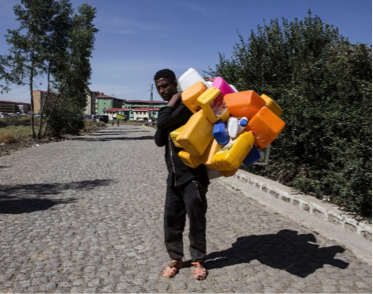
Where residents could walk to work, evidence of gains from employment were clear. In the Northern eThekwini case, relative proximity to areas of growing economic activity were positive for some, but particularly where walking was possible. These access challenges were matched in the Addis cases too, particularly for residents in Tulu Dimtu, in the south of the city. Long waiting times and poor connections affected residents’ quality of life and employability. Across all cases, the irregularity of work and poor pay was a persistent concern. In Addis, employment in the construction sector tied to the house programme was often temporary, and residents cited periods of unemployment and low income as a challenge for them. Unaffordability (to pay for housing in Addis, and then across all cases to cover transport costs, food, services, schooling, medical care etc.) was a common theme tied to these economic challenges.
Unemployment particularly affected youth across the cities, but age discrimination in some public works programmes in South Africa meant middle-aged residents suffered too. Despite focusing explicitly on investment in our cases (e.g. into major infrastructure works, shopping malls, industry etc.) there was little evidence that large scale investments were translating into actual opportunities for residents, often because of skills mismatches, or access problems identified above. Attempts to revitalise decaying industrial parks developed through apartheid decentralisation policies focussed more on supply-driven infrastructure provision for the private sector than on sustainable or innovative industrial development which would create vibrant economic activity on the periphery. More positively, cheaper and more available space in the peripheries and lower levels of competition meant some could establish livelihoods through entrepreneurialism more easily in these areas.
The importance of ‘micro infrastructure’
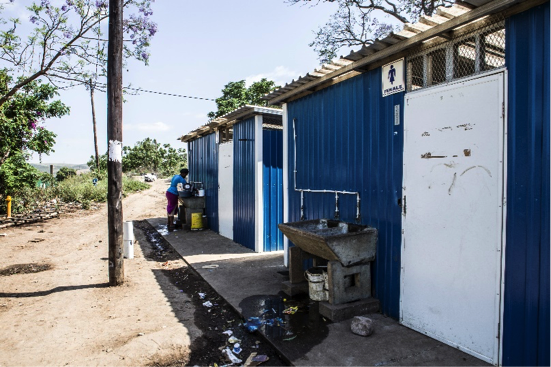
Our finding that larger scale infrastructural investments, such an the airport mega project in northern eThekwini, proved to be less significant for residents, counters much of the recent urban theory research on and interest in this ‘larger scale’ infrastructure. Instead, a persistent finding from our project was that localised and small-scale infrastructure which we term micro-infrastructure, was highly significant for residents, directly affecting their well being. Our data points to the importance of investments in road surfacing, toilet blocks, bus shelters, taps, and community gardens among other things. The absence of effective or working micro-infrastructure impacted on residents significantly, particularly reliable sources of water, electricity, schools and shops.
Micro-infrastructure was a key characteristic differentiating the periphery, with extreme variations found, often between adjacent sites. The importance of these smaller investments to residents emerged through a focus on the lived experiences of urban change, allowing us to observe that bigger investments can often pass many residents by. This can be for many reasons, but commonly relate to their lack of access (spatially or politically), or lack of skills or social capital.
One important discovery was the seemingly positive role played by shopping malls across all South African cases. Residents regarded their presence very positively, as they played a key role in disbursing welfare payments and providing access to a wider range of food and goods. Yet malls offered little in the way of employment to residents in our study illustrating again skills mismatches and an overall shortage of work.
Housing
The one dominating large infrastructural investment that significantly shaped lives in the peripheries was that of housing. State housing schemes dominated across all cases, but varied in their success. In South Africa this was in the form of the ‘free at the point of delivery’ RDP state houses, usually detached single storey properties, but with some variations in design extending to two-storey terraced homes.
In Ethiopia, shared payment condominium housing ranging from around four to eight floors in height were evident in both sites. In some cases relatively good location, good design, functional neighbourhood facilities and relatively low costs of living positively shaped the experiences of this housing for residents. In Addis, the inclusion of retail units on the ground floor of some condominiums, and the strong involvement of local committees for home-owners, worked to add vibrancy, goods and services, a sense of community and some green space for residents.
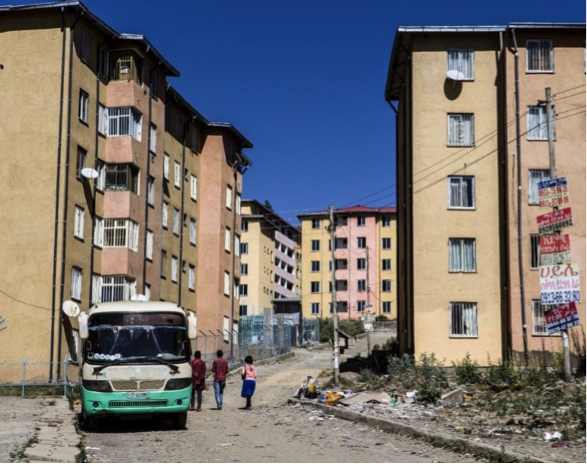
There was clear evidence across most cases of areas of middle and upper class private sector housing, evidencing relatively high investments in construction, design, décor, services and security. Sometimes these were extensions of previous state provided properties. In other cases, experiences of the unaffordability of new state housing dominated residents’ lives: ‘Thank God we got houses but hunger is killing us inside those houses’ (EM, Lufhereng, 2017). This coupled with poor construction, limited access to services especially water, and a sense of social breakdown typified residents’ experiences.
Informal settlements persisted across all cases, usually revealing very poor living conditions, although with some benefitting from state investments in toilet blocks and water supplies.
Life in the peripheries: boredom, pleasure and everyday politics
Finally, our project revealed a mixed picture of social and political trends in these urban peripheries. Socially, boredom was a significant feature in particular cases, especially those in Gauteng. Residents used this term to describe the lack of work, the absence of recreational and cultural facilities, and the dearth of shops, leaving them with little to do. Drugs, alcohol abuse, rising rates of crime and violence were all prevalent. At the same time, some residents noted that the peripheries were peaceful, quiet, provided fresh air and space, and that they felt safe. The persistence of a rural way of life was enjoyed by several respondents: “Living in this area has a distinct feeling… In any other part of Addis Ababa, you don’t see farmers farming, collecting, preparing and storing their harvest and that creates a certain form of joy” (010, Diary, Tulu Dimtu). Many cherished their social networks and celebrated recent investments in local schools and health and sporting centres. These differentiated experiences depended on a range of factors.
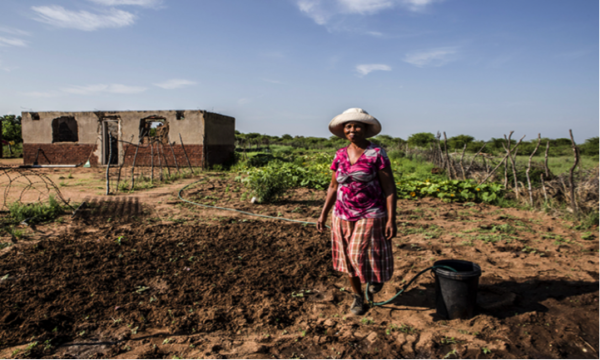
Politically the peripheries depicted many of the same trends found in more centralised urban spaces (the dominance of party politics, clientalistic relations), but we also found evidence of ‘strong men’ who utilised the periphery to gain power through controlling access to resources, particularly housing, electricity and work. In the western eThekwini case of Molweni, there was also evidence of a surprisingly well-functioning form of hybrid governance with traditional authorities working alongside municipalities – although this did not prevent clear inequities in investment at the local scale.
In Addis we noted well-functioning local committee structures directly influencing local decision-making. Across all cases, the need for a longitudinal view was essential to capture the significant changes in national governance regimes, which have intimately shaped these cities. These include Apartheid’s industrial decentralisation programme and practices of forced relocations, but also the dynamic spatial changes, particularly to borders and boundaries over time, which in the case of Addis continue to cause friction as the city is seen to be expanding into contested territory.
The importance of the periphery to urban change
In conclusion, as is evident, our findings are highly varied and this blog provides a brief snapshot of these. We are currently working on a preliminary categorisation of these multi-faceted peripheries noting five overlapping, incomplete and dynamic forms, which we have termed as follows: the speculative periphery, the vanguard periphery, the auto-constructed periphery, the transitioning periphery and the lagging periphery. Our future writing will expand and extend these categorisations, and also test their intellectual and policy significance in relation to our cases and potentially others. Importantly in terms of our original aim to understand what shapes lives in the peripheries and how these are experienced, we continue to analyse and consider what our work tells us about efforts to enhance urban inclusion and reduce poverty – critical policy ambitions in rapidly changing cities. Finally, we argue that the peripheries are key and dynamic spaces that should occupy a central focus in urban research.